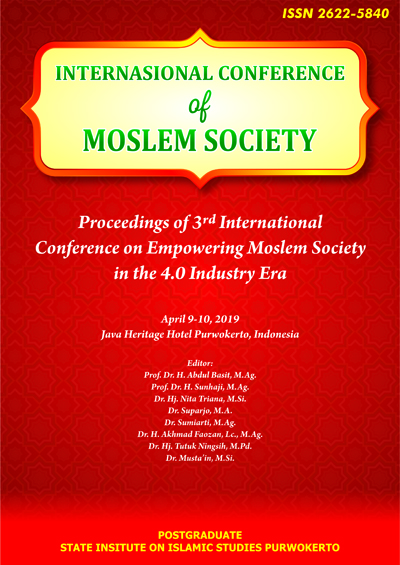Instilling Character Education in Early Childhood by Using Illustrated Storybook
DOI:
https://doi.org/10.24090/icms.2019.2481Keywords:
character education, early childhood, illustrated storybookAbstract
Early childhood is in its golden age and is very valuable compared to later ages. Early childhood experiences a very rapid process of growth and development. The intelligence of early childhood develops tremendously in absorbing everything in the surrounding environment. The golden age is a very decisive initial foundation in shaping the character and commendable personality and will adhere to adult children. Character education with an Islamic perspective will give birth to future generations who have quality personalities for the future of their lives in the future. Instilling character education in schools has an important role and spearheads the teacher. Character education is very appropriate to be implemented early. Early childhood does not know yet, has not been able to distinguish and does not yet know the effects of good deeds and bad deeds that they do. Educators should build the character of early childhood by introducing a variety of goodness, familiarizing and instilling pleasure to do good deeds. Learning method that can be applied to instill character from early childhood is through storytelling methods using illustrated storybook. Illustrated storybook is very interesting for early childhood because children can see various things and can develop imagination or fantasy, train emotions, attention and build the character of the child so that the Indonesian people have a future generation with good character.Downloads
Download data is not yet available.
References
Ali, A.M. (2018). Character Education Concept and Implementation. Jakarta: Prenadamedia.
Fadillah, M. (2014). PAUD learning Design. Yogyakarta: Ar-Ruzz Media.
Lickona, T. (1992). Educating For Character: How Our Scholl Can Teach Respect and Responsibility. New York: Bantam Books.
Mulyani, N. (2016). Basics of Early Childhood Education. Yogyakarta: Kalimedia.
Mustofa, B. (2015). Launching Children’s Intelligence Through Tales. Yogyakarta: Parama Ilmu.
Susanto, A. (2017). Early Childhood Education : Concepts and Theories. Jakarta: Bumi Aksara.
Wibowo, A. (2013). Early Childhood Education (Character Building Strategy at the Age of Gold). Yogyakarta: Pustaka Pelajar.
Wiyana, N.A., & Barnawi. (2016). PAUD Format: Concepts, Characteristics & Implementation of Early Childhood Education. Jogyakarta: Ar-Ruzz Media.
Fadillah, M. (2014). PAUD learning Design. Yogyakarta: Ar-Ruzz Media.
Lickona, T. (1992). Educating For Character: How Our Scholl Can Teach Respect and Responsibility. New York: Bantam Books.
Mulyani, N. (2016). Basics of Early Childhood Education. Yogyakarta: Kalimedia.
Mustofa, B. (2015). Launching Children’s Intelligence Through Tales. Yogyakarta: Parama Ilmu.
Susanto, A. (2017). Early Childhood Education : Concepts and Theories. Jakarta: Bumi Aksara.
Wibowo, A. (2013). Early Childhood Education (Character Building Strategy at the Age of Gold). Yogyakarta: Pustaka Pelajar.
Wiyana, N.A., & Barnawi. (2016). PAUD Format: Concepts, Characteristics & Implementation of Early Childhood Education. Jogyakarta: Ar-Ruzz Media.
Downloads
Published
2019-04-12
How to Cite
Retnaningrum, W. (2019). Instilling Character Education in Early Childhood by Using Illustrated Storybook. International Conference of Moslem Society, 3, 1–10. https://doi.org/10.24090/icms.2019.2481
Issue
Section
ICMS 2019
License
Authors who publish with this journal agree to the following terms:
- Authors retain copyright and grant the journal right of first publication with the work simultaneously licensed under a Creative Commons Attribution-ShareAlike 4.0 License that allows others to share the work with an acknowledgement of the work's authorship and initial publication in this journal.
- Authors are able to enter into separate, additional contractual arrangements for the non-exclusive distribution of the journal's published version of the work (e.g., post it to an institutional repository or publish it in a book), with an acknowledgement of its initial publication in this journal.
- Authors are permitted and encouraged to post their work online (e.g., in institutional repositories or on their website) prior to and during the submission process, as it can lead to productive exchanges, as well as earlier and greater citation of published work (See The Effect of Open Access).


